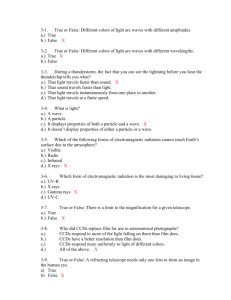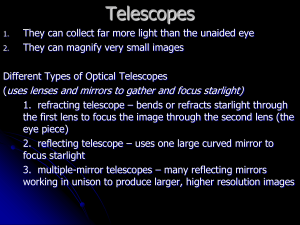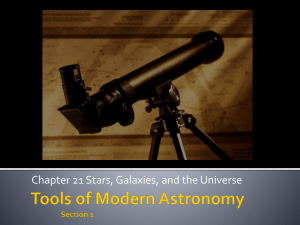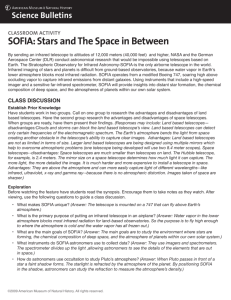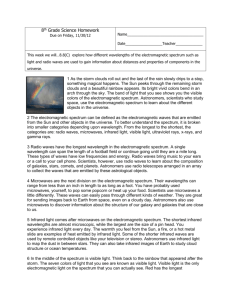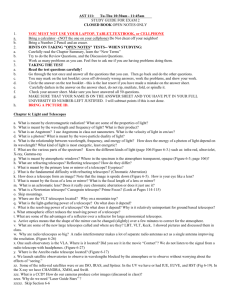Observing Light Across The Electromagnetic Spectrum
advertisement
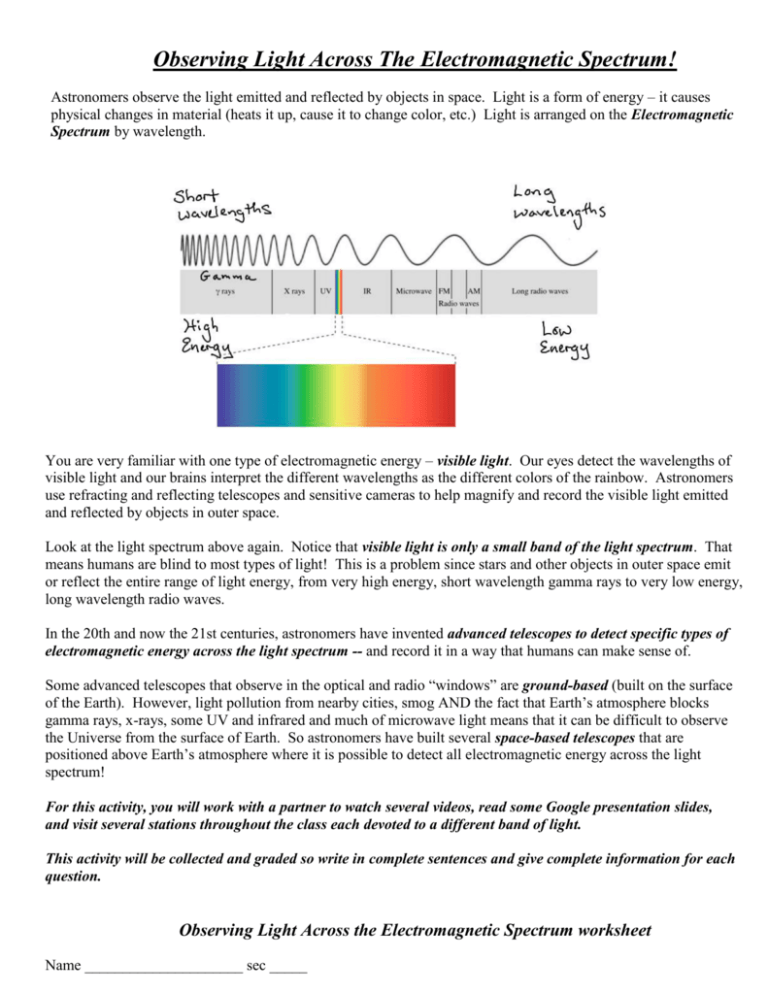
Observing Light Across The Electromagnetic Spectrum! Astronomers observe the light emitted and reflected by objects in space. Light is a form of energy – it causes physical changes in material (heats it up, cause it to change color, etc.) Light is arranged on the Electromagnetic Spectrum by wavelength. You are very familiar with one type of electromagnetic energy – visible light. Our eyes detect the wavelengths of visible light and our brains interpret the different wavelengths as the different colors of the rainbow. Astronomers use refracting and reflecting telescopes and sensitive cameras to help magnify and record the visible light emitted and reflected by objects in outer space. Look at the light spectrum above again. Notice that visible light is only a small band of the light spectrum. That means humans are blind to most types of light! This is a problem since stars and other objects in outer space emit or reflect the entire range of light energy, from very high energy, short wavelength gamma rays to very low energy, long wavelength radio waves. In the 20th and now the 21st centuries, astronomers have invented advanced telescopes to detect specific types of electromagnetic energy across the light spectrum -- and record it in a way that humans can make sense of. Some advanced telescopes that observe in the optical and radio “windows” are ground-based (built on the surface of the Earth). However, light pollution from nearby cities, smog AND the fact that Earth’s atmosphere blocks gamma rays, x-rays, some UV and infrared and much of microwave light means that it can be difficult to observe the Universe from the surface of Earth. So astronomers have built several space-based telescopes that are positioned above Earth’s atmosphere where it is possible to detect all electromagnetic energy across the light spectrum! For this activity, you will work with a partner to watch several videos, read some Google presentation slides, and visit several stations throughout the class each devoted to a different band of light. This activity will be collected and graded so write in complete sentences and give complete information for each question. Observing Light Across the Electromagnetic Spectrum worksheet Name _____________________ sec _____ Station 1 – Radio Waves 1. Watch the video and answer the following question -- What are two everyday objects that have similar length to Radio Waves? 2. Go to Station 1 and follow the instructions there. think about the length of Radio Waves and offer an explanation for why the wire mesh is able to block radiowaves from reaching the transistor radio? 3. Why does the radio function again once you reach in and touch the antenna? 4. Based on the video and on the information on the slide – describe TWO features of the ground-based Arecibo telescope and ONE feature of the New Mexico array that permit these two ground-based telescopes to observe Radio Waves from space Arecibo (Puerto Rico) – New Mexico array – Station 2 – Microwaves 5. Watch the video and answer the following question -- What are two everyday objects that have similar length to Microwaves? 6. What would the Cosmic Microwave Background energy look like if our eyes could perceive this band of light? What does the presence of the Cosmic Microwave Background help astronomers better understand about our universe? 7. From the Google pres., why does the ground-based Microwave telescope need to be located in Antarctica? 8. Go to Station 2 and follow the instructions there to place a phone call from the classroom landline to my cell phone. Which material -- aluminum foil or paper bag-- is transparent to microwaves and so allows my cellphone to receive a call? Station 3 – Infrared light 9. We can’t see infrared, but how do our bodies sense it? 10. Go to Station 3 and follow the instructions there. Take a picture of the infrared signal sent by the remote and show me!! Identify the material(s) that block the infrared signal sent by remote to the DVD player? Which material(s) are transparent to the signal and allow the remote to control the DVD player? 11. From the Google slide, what major discovery about Saturn was made possible with a Spitzer Space Telescope? 12. From the video, what other major discovery did the Spitzer Space Telescope make about the Orion Nebula? Station 4 – Visible light 13. Go to Station 4 and follow the instructions there. What colors of visible light does the incandescent bulb emit? Is one particular end of the visible light spectrum (the red end or the blue end) brighter than the other? This explains why people look “healthy” under incandescent lighting and colors appear “warmer” under incandescent lighting. 14. Are there any colors that the fluorescent lights don’t emit, or only emit a little bit (these colors appear dull or dim in the spectroscope)? This helps explain why people appear “pale” under fluorescent lighting and colors appear “cooler” under fluorescent lighting. 15. From the Google slide, look at the beautiful Ultra Deep Field image made by the Hubble Space Telescope using visible light. What types of objects are shown in this image of deep space? 16. From the video, explain why Earth’s atmosphere looks blue to our human eyes and explain why our Sun appears yellow. Station 5 – Ultraviolet light 17. Go to Station 5 and follow the instructions there. What type of glass material (plastic or glass) blocked the UV light from changing the color of the UV beads? 18. From the video, explain why it is necessary to for telescopes to be space-based to study young stars. 19. From the video, what has the Cassini probe observed about Saturn using Ultraviolet light? 20. From the Google slide, explain what impacts to humans the SOHO telescope can help forecast from impending “space weather”? Station 6 – X-rays 21. Go to Station 6 and follow the instructions there. What body part was X-rayed? What bone appears to be broken based on your interpretation of the X-ray? 22. Why do women need to wear a lead apron across their torso when they have X-rays taken? 23. From the video, what has the Chandra space telescope helped us observe in space/ 24. From the Google Slide, what has the Chandra space telescope helped us observe about the Crab Nebula.

